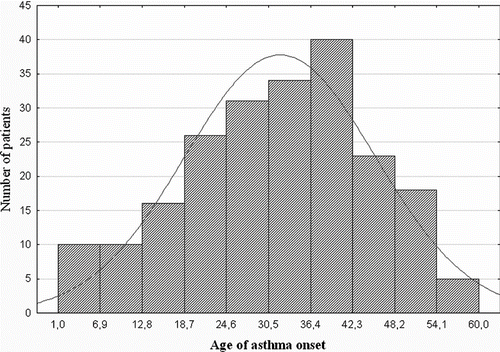In the Journal of Asthma 2009; 46(5): 523–528 for the article “Genetic Variation of Myeloperoxidase Gene Contributes to Atopic Asthma Susceptibility: A Preliminary Association Study in Russian Population”, the legends were missing in .
Figure 1. Distribution of asthmatics in respect to the age of the disease onset. The represents a distribution of asthmatics in respect to the age of the disease onset. The thin curve shows a fitting to the normal distribution.

Figure 2. Proposed mechanisms of the involvement of MPO-463G > A polymorphism in the pathogenesis of asthma. I.Since a key function of MPO is the production of hypohalous acids which are strong oxidants with potent antibacterial properties [31], the increased release of MPO and its highly reactive byproducts can cause amplification of the oxidizing antimicrobial potential of granulocytes. The granulocytes could excessively kill bacteria and, therefore, decrease the host exposure to bacterial endotoxins leading to allergen sensitization, as it was originally proposed by the hygiene hypothesis of asthma [32]. II. The enhanced promoter activity of the MPO gene leads to an abundant release of the enzyme and its reactive byproducts, such as hypochlorous and hypobromous acids, at inflammatory sites could damage respiratory cells through the increased oxidative stress [33, 34]. The MPO-hypochlorous acid pathway is able to generate reactive nitrogen species, oxygen and tyrosyl radicals [10], which can react with biologic molecules to produce secondary cytotoxic free radicals [9, 35] increasing lung inflammation. III. The increased MPO release from granulocytes in lung tissue can be in response to exposure to various pulmonary insults, including tobacco smoke and pollutants [8]. In addition to the direct damaging effects of the oxidants generated by MPO, the enzyme activates polycyclic aromatic hydrocarbons and arylamines (derived from tobacco smoke and pollutants) into their highly reactive toxic intermediates responsible for the oxidative injury of respiratory cells and airway hyperresponsiveness [16, 33, 36, 37].
![Figure 2. Proposed mechanisms of the involvement of MPO-463G > A polymorphism in the pathogenesis of asthma. I.Since a key function of MPO is the production of hypohalous acids which are strong oxidants with potent antibacterial properties [31], the increased release of MPO and its highly reactive byproducts can cause amplification of the oxidizing antimicrobial potential of granulocytes. The granulocytes could excessively kill bacteria and, therefore, decrease the host exposure to bacterial endotoxins leading to allergen sensitization, as it was originally proposed by the hygiene hypothesis of asthma [32]. II. The enhanced promoter activity of the MPO gene leads to an abundant release of the enzyme and its reactive byproducts, such as hypochlorous and hypobromous acids, at inflammatory sites could damage respiratory cells through the increased oxidative stress [33, 34]. The MPO-hypochlorous acid pathway is able to generate reactive nitrogen species, oxygen and tyrosyl radicals [10], which can react with biologic molecules to produce secondary cytotoxic free radicals [9, 35] increasing lung inflammation. III. The increased MPO release from granulocytes in lung tissue can be in response to exposure to various pulmonary insults, including tobacco smoke and pollutants [8]. In addition to the direct damaging effects of the oxidants generated by MPO, the enzyme activates polycyclic aromatic hydrocarbons and arylamines (derived from tobacco smoke and pollutants) into their highly reactive toxic intermediates responsible for the oxidative injury of respiratory cells and airway hyperresponsiveness [16, 33, 36, 37].](/cms/asset/b5cbe81a-f157-4d82-a8df-bb04d61facad/ijas_a_436677_f0002_b.gif)